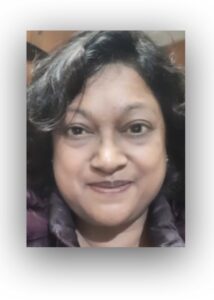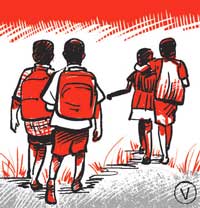“Development means nothing if it does not lead to human development in its broadest sense. It must have components of healthcare for everybody, education for everybody, and food security for everybody; and in this the role of the state is vital. Equality starts with economic equality.” – Summary of Professor Kurien’s books by Parvathy Menon in “At 90, C.T. Kurien – Scholar of Social Conscience – Is More Relevant Than Ever” (The Wire, 5 July 2021)
“When you are leaving 60 percent of the people behind, you cannot have the ambition to be an economic power.” – Poonam Muttreja (Executive Director of the Population Foundation of India, a New Delhi-based research organization) >>
Adivasis in India receive the “lowest-cost, poorest-quality and indifferently administered education”, a [2012] study backed by the UNICEF has revealed. Not only are the Adivasis marginalised, even affirmative action/reservation programmes for Adivasis (as Scheduled Tribes) in higher educational institutions have not had the desired effect, the report suggests.
Conducted by the National Institute of Advanced Studies, Bangalore, the study found that mainstream education has failed to recognise the aspirations, needs and predicament of Adivasis. […]
Submitted to UNICEF last week, the report is a broad perspective on Adivasi education in India noting the “systemic” marginalisation and ‘invisibilisation” of adivasi interests across political, policy and administrative levels. Indigenous adivasi culture, knowledge forms and language find no place in the dominant education system, it notes.
The report uses the term Adivasi for groups identified as ‘tribals, ‘scheduled tribes’ and ‘denotified tribes’ across India. There are more than 600 Adivasi/tribal communities in India and most of them are among the most disadvantaged social groups.
Reviewing a number of educational programmes for tribals in institutes and schools in educationally backward blocks to fully residential Kasturba Gandhi Balika Vidyalayas and ashramshalas, apart from fellowships for ST students, the report points to how the many tribal specific schemes run by the government are mostly poorly implemented, go un-monitored, and are often parallel and inadequate. […]
Source: “UNICEF-backed study paints poor picture of Adivasi education” by Anubhuti Vishnoi, Indian Express, 28 August 2012
Address : http://www.indianexpress.com/news/unicefbacked-study-paints-poor-picture-of-adivasi-education/993978
Date Visited: Thu Jan 03 2013 20:56:35 GMT+0100 (CET)

Ādivāsi [ādibāsi] may be used in accordance with local conventions; and increasingly so for official purposes (e.g. in “Conserving Tradition and Practices of Adivasi Communities in India” published on NIDM.gov.in); Dr. Ivy Hansdak clarifies:
“Adivasi – which is derived from Sanskrit – is applied to the dark-skinned or Austro-Asiatic indigenous groups of India (usually those from Eastern India). It is a commonly-used term in Jharkhand, Bihar, West Bengal and Odisha. It is also used by the local Mongoloid tribes of North Eastern India for the migrant workers who were brought in as indentured labourers to work in tea plantations during the colonial period. ‘Tribal’ is a very broad term in the English language and includes all the different indigenous groups of India. The terms ‘indigenous’ and ‘aboriginal’ are not used often as the government claims most groups are indigenous in India. ‘Denotified Tribes’ is only used for those nomadic tribes who were notified as ‘criminal tribes’ during the British Raj [colonial rule]; later they were ‘denotified’ but still bear the stigma.” (emails dated 2020 & 2023)
“Tribal groups (adivasis) in India have often been excluded, marginalized and oppressed by ‘mainstream’ society. In many ways this exclusion, marginalization and oppression is fostered by the way in which ‘mainstream’ society looks at the adivasis – as exotic, dangerous, or ‘primitive’ others.” – Ganesh [G.N.] Devy in A Nomad Called Thief: Reflections on Adivasi Silence and Voice | Classifications in different states >>
“Tribals are subject to oppression and cruelty even after independence and still picked up by the investigating officers to cover up shoddy investigations.” – D.Y. Chandrachud (Chief Justice of India since 9 November 2022) quoted in “Members of De-Notified Tribes Picked Up to Cover Up Shoddy Investigations” | Learn more >>
“Since the Indian Constitution uses the term ‘Scheduled Tribes’ or ‘tribals’ to refer to indigenous communities in India and the colloquial reference used by several indigenous communities themselves is ‘adivasis’ these two terms shall be used interchangeably.” – Rebecca S . David in “An analysis of the impact of the Forest Rights Act (2006) in three states of India” (MPhil University of Cambridge, UK, 2014), p. 1 | Learn more | Classifications in different states >>
“Adivasis are not a homogeneous group; there are over 200 distinct peoples speaking more than 100 languages, and varying greatly in ethnicity and culture.” – Source: World Directory of Minorities and Indigenous Peoples – India | Learn more | Classifications in different states >>
In line with Yiftachel’s formulation of an ethnocracy, we are witnessing the consolidation of the dominant ethnos, Hindus in this case, as the core of the Indian nation. Alongside, we see the identification of religious minorities as threats, intensifying territorial contests between Hindus and Muslim, a Hindutva ethnonationalism that permeates political discourse, and a widening of a long-standing political-economic gap between Hindus and Muslims. […]
Some scholars have argued that “India increasingly demonstrates a key feature of an ethnic democracy and associated two-tiered citizenship, with the Hindu majority enjoying more de jure and de facto rights than the Muslim minority” (Jaffrelot 2019: 42; see also Adeney 2020). These formulations of “ethnic democracy” usefully caution against an uncritical acceptance of India as a liberal democracy, but they downplay the extent to which democracy in India is reduced to the shell of holding regular elections. To be sure, the dominant groups in ethnocracies value democracy (at least for themselves) and often take pride in their democratic institutions. But a polity based on the structural exclusion of a section of its population cannot reasonably be said to qualify as a democracy. Recent events in India, which have triggered bodies such as Freedom House and V-Dem to rethink India’s status as a democracy, make it imperative for us to take seriously the category of ethnocracy when reflecting on India’s democratic decline. […]
[T]he dominant groups in ethnocracies value democracy (at least for themselves) and often take pride in their democratic institutions. But a polity based on the structural exclusion of a section of its population cannot reasonably be said to qualify as a democracy. […]
Indrajit Roy is a senior lecturer in global development politics at the Department of Politics, York University. He leads Reimagining Citizenship, a global consortium of scholars and practitioners studying ongoing contentions over nationalism, belonging, and rights in India.
Source: Indrajit Roy India Forum (September 2021), citing a definition of ethnocracy by sociologist Oren Yiftachel (i.e. nationalism embraced by governments in states like Israel, Sri Lanka and Malaysia “where a dominant ethnos gains political control and uses the state apparatus to ethnicise the territory and society in question” (Yiftachel, 2009: 730)URL: https://www.theindiaforum.in/article/india-world-s-largest-democracy-ethnocracy
Date Visited: 2 January 2022
[Bold typeface added above for emphasis]
“The Big-brother attitude of educators must end. The approach to tribal education has to be a two-way transaction of give and take, based on an informed appreciation of traditional tribal values and wisdom.” – Uma Ram (Professor & Head Department of English, Kakatiya PG College, Chhattisgarh) in Issues in Tribal Education in Bastar, Chhattisgarh (Folklore Foundation, Lokaratna, Volume IV 2011)
Residential, Ashram and Factory schools
- Ekalavya* Residential School Scheme (EMR): a network of boarding schools where tribal children are to be educated in accordance with rules and syllabi provided by the government; such schools are being designated as “Eklavya Model Residential School (EMR)” with the objective of empowering students “to be change agent, beginning in their school, in their homes, in their village and finally in a large context.” – Government Guidelines 2010 | Backup >>
- Residential School and Ashram School
In some regions there are similar “Residential Schools” and “Ashram Schools” for tribal children, as in Tripura where they are managed by a society called “Tripura Tribal Welfare Residential Educational Institutions Society (TTWREIS)” – Tribal Welfare Department, Government of Tripura - Factory schools “exist to turn tribal and indigenous children – who have their own language and culture – into compliant workers-of-the-future. The world’s largest Factory School stated that it turns ‘Tax consumers into tax payers, liabilities into assets’.” – survivalinternational.org/factoryschools | Learn more >>
Up-to-date information about these and related issues: Safe custom search engine >>
* Ekalavya (Eklavya, Eklabya): the name of a legendary archer prodigy “who, being a Nishada [Sanskrit Niṣāda, “tribal, hunter, mountaineer, degraded person, outcast”], had to give his thumb as a fee to the brahmin guru thus terminating his skill as an archer.” – Romila Thapar (“The epic of the Bharatas”) | Read the full paper here | Backup download link (pdf) >>
Note: “Forcibly transferring children of the group to another group” amounts to genocide, which the United Nations Office on Genocide Prevention defines as “acts committed with intent to destroy, in whole or in part, a national, ethnical, racial or religious group” (Article II, d & e)
Learn more about Childrens rights: UNICEF India | Ekalavya (Eklavya, Eklabya), EMR & Factory schools | Rights of Indigenous Peoples >>
Tip: click on any red marker for details on endangered languages in a particular region of India.
Please note: the facts and figures cited (via hyperlinks) links call for updates and fact checking >>
Cultural invisibility – India’s 600 potentially endangered languages | Linguistic Survey of India (official website) >>
